Design and Experimental Evaluation of an In-Wheel Flux-Switching Machine for Light Vehicle Application
Abstract
1. Introduction
2. State of Art
3. Methodology
3.1. Design Specifications and Restrictions
3.2. Analytical Modeling
3.3. Topology Considerations
3.4. Structural and Material Limitations
4. Model Validation
5. Conclusions
Author Contributions
Funding
Institutional Review Board Statement
Informed Consent Statement
Data Availability Statement
Acknowledgments
Conflicts of Interest
References
- IEA. Energy and Air Pollution; Technical Report; International Energy Agency (IEA): Paris, France, 2016.
- Mulholland, E.; Miller, J.; Braun, C.; Jin, L.; Rodríguez, F. Quantifying the long-term air quality and health benefits from Euro 7/VII standards in Europe. In The International Council of Clean Transportation. ICCT Briefing June; ICCT: San Francisco, CA, USA, 2021. [Google Scholar]
- Coimbra, M.R.; Barbosa, T.P.; Vasques, C.M. A 3D-Printed Continuously Variable Transmission for an Electric Vehicle Prototype. Machines 2022, 10, 84. [Google Scholar] [CrossRef]
- Nikowitz, M. Advanced Hybrid and Electric Vehicles; Springer International Publishing: Berlin/Heidelberg, Germany, 2016. [Google Scholar] [CrossRef]
- Ismail, M.M.R.; Wira, J.Y.; Abu, A.; Abidin, M.A.Z. Thermal Energy Harvesting From Automotive Waste Heat. Adv. Mater. Res. 2012, 516–517, 498–503. [Google Scholar] [CrossRef]
- Zhou, F.; Dede, E.; Joshi, S. Application of Rankine Cycle to Passenger Vehicle Waste Heat Recovery—A Review. SAE Int. J. Mater. Manuf. 2016, 9, 224–235. [Google Scholar] [CrossRef]
- Maia, T.A.; Faria, O.A.; Barros, J.E.; Porto, M.P.; Cardoso Filho, B.J. Test and simulation of an electric generator driven by a micro-turbine. Electr. Power Syst. Res. 2017, 147, 224–232. [Google Scholar] [CrossRef]
- Simões, A.N.; Carvalho, D.J.; Morita, E.d.S.; Moretti, H.L.; Vendrameto, H.V.; Fu, L.; Torres, F.; Souza, A.N.d.; Bizzo, W.A.; Mazon, T. A Triboelectric Nanogenerator for Energy Harvesting from Transformers’ Vibrations. Machines 2022, 10, 215. [Google Scholar] [CrossRef]
- Carneiro, P.M.; Ferreira, J.A.; Kholkin, A.L.; Soares dos Santos, M.P. Towards Self-Adaptability of Instrumented Electromagnetic Energy Harvesters. Machines 2022, 10, 414. [Google Scholar] [CrossRef]
- Aksu, U.; Halicioglu, R. A review study on energy harvesting systems for vehicles. Teh. Glas. 2018, 12, 251–259. [Google Scholar] [CrossRef]
- Abdelkareem, M.A.A.; Xu, L.; Ali, M.K.A.; Elagouz, A.; Mi, J.; Guo, S.; Liu, Y.; Zuo, L. Vibration energy harvesting in automotive suspension system: A detailed review. Appl. Energy 2018, 229, 672–699. [Google Scholar] [CrossRef]
- Da Silva, J.F.F.G. Challenges for the Electric Mobility Transition: Lessons from Norway and Perspectives for Brazil. Master’s Thesis, FGV, Rio de Janeiro, Brazil, 2019. [Google Scholar]
- Cardoso, D.S.; Fael, P.O.; Espírito-Santo, A. A review of micro and mild hybrid systems. Energy Rep. 2020, 6, 385–390. [Google Scholar] [CrossRef]
- Chau, K.T.C. Electric Vehicle Machines and Drives: Design, Analysis and Application; John Wiley & Sons: Hoboken, NJ, USA, 2015. [Google Scholar]
- Picron, V.; Fournigault, D.; Baudesson, P.; Armiroli, P. Cost-Efficient Hybrid Powertrain System with 48 V Network. ATZ Worldw. 2012, 114, 46–50. [Google Scholar] [CrossRef]
- Li, C.; Guo, X.; Fu, J.; Fu, W.; Liu, Y.; Chen, H.; Wang, R.; Li, Z. Design and Analysis of a Novel Double-Stator Double-Rotor Motor Drive System for In-Wheel Direct Drive of Electric Vehicles. Machines 2021, 10, 27. [Google Scholar] [CrossRef]
- Solliec, G.L.; Chasse, A.; Van-Frank, J.; Walser, D. Dual Mode Vehicle with In-Wheel Motor: Regenerative Braking Optimization. Oil Gas Sci. Technol. Rev. D’IFP Energies Nouv. 2013, 68, 95–108. [Google Scholar] [CrossRef][Green Version]
- Lambert, T.; Biglarbegian, M.; Mahmud, S. A novel approach to the design of axial-flux switched-reluctance motors. Machines 2015, 3, 27–54. [Google Scholar] [CrossRef]
- Sabri, M.F.M.; Danapalasingam, K.A.; Rahmat, M.F. A review on hybrid electric vehicles architecture and energy management strategies. Renew. Sustain. Energy Rev. 2016, 53, 1433–1442. [Google Scholar] [CrossRef]
- Spichartz, P.; Bokker, T.; Sourkounis, C. Comparison of electric vehicles with single drive and four wheel drive system concerning regenerative braking. In Proceedings of the 2017 Twelfth International Conference on Ecological Vehicles and Renewable Energies (EVER), Monte Carlo, Monaco, 11–13 April 2017. [Google Scholar] [CrossRef]
- European Commission. Commission Regulation (EU) 2017/1151 of 1 June 2017 supplementing Regulation (EC) No. 715/2007 of the European Parliament and of the Council on type-approval of motor vehicles with respect to emissions from light passenger and commercial vehicles (Euro 5 and Euro 6) and on access to vehicle repair and maintenance information, amending Directive 2007/46/EC of the European Parliament and of the Council, Commission Regulation (EC) No. 692/2008 and Commission Regulation (EU) No. 1230/2012 and repealing Commission Regulation (EC) No. 692/2008. Off. J. Eur. Union 2017, 175, 1–643. [Google Scholar]
- Cui, M.; Zhao, S.; Deguchi, Y.; Chen, C.; Fan, D. Performance of flux switching integrated starter-generator system with dual-mode control circuit. Int. J. Mechatron. Autom. 2018, 6, 94. [Google Scholar] [CrossRef]
- Viorel, I.A.; Szabó, L.; Löwenstein, L. Integrated starter-generators for automotive applications. Acta Electroteh. 2004, 45, 7. [Google Scholar]
- Mirahki, H.; Moallem, M.; Rahimi, S.A. Design Optimization of IPMSM for 42 V Integrated Starter Alternator Using Lumped Parameter Model and Genetic Algorithms. IEEE Trans. Magn. 2014, 50, 114–119. [Google Scholar] [CrossRef]
- Bu, F.; Liu, H.; Huang, W.; Hu, Y.; Degano, M.; Gerada, C.; Rajashekara, K. Induction-Machine-Based Starter/Generator Systems: Techniques, Developments, and Advances. IEEE Ind. Electron. Mag. 2020, 14, 4–19. [Google Scholar] [CrossRef]
- Wang, W.; Chen, X.; Wang, J. Motor/Generator Applications in Electrified Vehicle Chassis—A Survey. IEEE Trans. Transp. Electrif. 2019, 5, 584–601. [Google Scholar] [CrossRef]
- Xu, W.; Zhao, H.; Ren, B.; Chen, H. A regenerative braking control strategy for electric vehicle with four in-wheel motors. In Proceedings of the 2016 35th Chinese Control Conference (CCC), Chengdu, China, 27–29 July 2016. [Google Scholar] [CrossRef]
- Rizzo, G.; Naghinajad, S.; Tiano, F.; Marino, M. A Survey on Through-the-Road Hybrid Electric Vehicles. Electronics 2020, 9, 879. [Google Scholar] [CrossRef]
- Zhao, X.; Kou, B.; Huang, C.; Zhang, L. Optimization design and performance analysis of a reverse-salient permanent magnet synchronous motor. Machines 2022, 10, 204. [Google Scholar] [CrossRef]
- Ocana, I.M.; Baker, N.J.; Mecrow, B.C.; Gan, C.; Hilton, C.; Brockway, S. Testing of an in-wheel Halbach array motor. In Proceedings of the 2020 International Conference on Electrical Machines (ICEM), Gothenburg, Sweden, 23–26 August 2020. [Google Scholar] [CrossRef]
- Wang, X.; Wu, L.; Zhou, S.; Hu, C.; Zhao, M. Optimization Design of In-wheel Motor Based on Halbach (Ce,Nd)FeB Magnet. In Proceedings of the 2019 22nd International Conference on Electrical Machines and Systems (ICEMS), Harbin, China, 11–14 August 2019. [Google Scholar] [CrossRef]
- Gao, P.; Gu, Y.; Wang, X. The Design of a Permanent Magnet In-Wheel Motor with Dual-Stator and Dual-Field-Excitation Used in Electric Vehicles. Energies 2018, 11, 424. [Google Scholar] [CrossRef]
- Akatsu, K.; Fukuda, K. Advanced Control Method of 5-Phase Dual Concentrated Winding PMSM for Inverter Integrated In-Wheel Motor. World Electr. Veh. J. 2021, 12, 61. [Google Scholar] [CrossRef]
- Agamloh, E.; von Jouanne, A.; Yokochi, A. An Overview of Electric Machine Trends in Modern Electric Vehicles. Machines 2020, 8, 20. [Google Scholar] [CrossRef]
- Jahns, T. Getting Rare-Earth Magnets Out of EV Traction Machines: A review of the many approaches being pursued to minimize or eliminate rare-earth magnets from future EV drivetrains. IEEE Electrif. Mag. 2017, 5, 6–18. [Google Scholar] [CrossRef]
- Boldea, I.; Tutelea, L.N.; Parsa, L.; Dorrell, D. Automotive Electric Propulsion Systems With Reduced or No Permanent Magnets: An Overview. IEEE Trans. Ind. Electron. 2014, 61, 5696–5711. [Google Scholar] [CrossRef]
- Fujishiro, S.; Ishikawa, K.; Kikuchi, S.; Nakamura, K.; Ichinokura, O. Design of outer-rotor-type multipolar switched reluctance motor for electric vehicle. J. Appl. Phys. 2006, 99, 08R324. [Google Scholar] [CrossRef]
- Nikam, S.P.; Rallabandi, V.; Fernandes, B.G. A High-Torque-Density Permanent-Magnet Free Motor for in-Wheel Electric Vehicle Application. IEEE Trans. Ind. Appl. 2012, 48, 2287–2295. [Google Scholar] [CrossRef]
- Goto, H. Double Stator Axial-Flux Switched Reluctance Motor for Electric City Commuters. In Proceedings of the 2018 International Power Electronics Conference (IPEC-Niigata 2018—ECCE Asia), Niigata, Japan, 20–24 May 2018. [Google Scholar] [CrossRef]
- Patel, N.R.; Shah, V.A.; Lokhande, M.M. A Novel Approach to the Design and Development of 12/15 Radial Field C-Core Switched Reluctance Motor for Implementation in Electric Vehicle Application. IEEE Trans. Veh. Technol. 2018, 67, 8031–8040. [Google Scholar] [CrossRef]
- Ahmad, N.; Khan, F.; Ali, H.; Ishaq, S.; Sulaiman, E. Outer rotor wound field flux switching machine for In-wheel direct drive application. IET Electr. Power Appl. 2019, 13, 757–765. [Google Scholar] [CrossRef]
- Ali, H.; Sulaiman, E.; Kosaka, T. Design and performance analysis of various high torque segmented rotor HE-FSM topologies for aircraft applications. IET Electr. Power Appl. 2020, 14, 297–304. [Google Scholar] [CrossRef]
- Tang, Y.; Motoasca, E.; Paulides, J.J.; Lomonova, E.A. Comparison of flux-switching machines and permanent magnet synchronous machines in an in-wheel traction application. COMPEL Int. J. Comput. Math. Electr. Electron. Eng. 2012, 32, 153–165. [Google Scholar] [CrossRef]
- Raminosoa, T.; El-Refaie, A.M.; Pan, D.; Huh, K.K.; Alexander, J.P.; Grace, K.; Grubic, S.; Galioto, S.; Reddy, P.B.; Shen, X. Reduced Rare-Earth Flux-Switching Machines for Traction Applications. IEEE Trans. Ind. Appl. 2015, 51, 2959–2971. [Google Scholar] [CrossRef]
- Cao, Y.; Zhu, S.; Yu, J.; Liu, C. Optimization Design and Performance Evaluation of a Hybrid Excitation Claw Pole Machine. Processes 2022, 10, 541. [Google Scholar] [CrossRef]
- Dmitrievskii, V.; Prakht, V.; Kazakbaev, V.; Anuchin, A. Comparison of Interior Permanent Magnet and Synchronous Homopolar Motors for a Mining Dump Truck Traction Drive Operated in Wide Constant Power Speed Range. Mathematics 2022, 10, 1581. [Google Scholar] [CrossRef]
- Sulaiman, E.B.; Khan, F.; Kosaka, T. Field-Excited Flux Switching Motor Design, Optimization and Analyses for Future Hybrid Electric Vehicles Using Finite Element Analyses. Prog. Electromagn. Res. B 2016, 71, 153–166. [Google Scholar] [CrossRef]
- Mendonça, G.; Maia, T.; Filho, B.C. Magnetic Field Analytical Solution for Non-homogeneous Permeability in Retaining Sleeve of a High-Speed Permanent-Magnet Machine. Math. Comput. Appl. 2018, 23, 72. [Google Scholar] [CrossRef]
- Mendonça, G.A.; Maia, T.A.C.; de Jesus Cardoso Filho, B. Improved Semi-Analytical Magnetic Field Solution For High-Speed Permanent-Magnet Machines With Permeable Retaining Sleeve Including Diffusion Effect. Prog. Electromagn. Res. B 2020, 88, 97–118. [Google Scholar] [CrossRef]
- Ramakrishnan, K.; Curti, M.; Zarko, D.; Mastinu, G.; Paulides, J.J.H.; Lomonova, E.A. Comparative analysis of various methods for modelling surface permanent magnet machines. IET Electr. Power Appl. 2017, 11, 540–547. [Google Scholar] [CrossRef]
- Ehsani, M.; Gao, Y.; Longo, S.; Ebrahimi, K.M. Modern Electric, Hybrid Electric, and Fuel Cell Vehicles; CRC Press: Boca Raton, FL, USA, 2018. [Google Scholar]
- Nguyen, H.Q.; Jiang, J.Y.; Yang, S.M. Design of a 12-slot 7-pole wound-field flux switching motor for traction applications. In Proceedings of the 2016 IEEE International Conference on Industrial Technology (ICIT), Taipei, Taiwan, 14–17 March 2016. [Google Scholar] [CrossRef]
- Yang, S.M.; Zhang, J.H.; Jiang, J.Y. Modeling torque characteristics and maximum torque control of a three-phase, dc-excited flux-switching machine. IEEE Trans. Magn. 2016, 52, 1–4. [Google Scholar] [CrossRef]
- Balyovski, T.; Ilhan, E.; Tang, Y.; Paulides, J.; Wijnands, C.; Lomonova, E. Control of DC-excited flux switching machines for traction applications. In Proceedings of the 2014 Ninth International Conference on Ecological Vehicles and Renewable Energies (EVER), Monte-Carlo, Monaco, 25–27 March 2014; pp. 1–5. [Google Scholar]
- Amara, Y.; Hoang, E.; Gabsi, M.; Lécrivain, M.; Allano, S. Design and comparison of different flux-switch synchronous machines for an aircraft oil breather application. Eur. Trans. Electr. Power 2005, 15, 497–511. [Google Scholar] [CrossRef]
- Zhou, Y.J.; Zhu, Z.Q. Comparison of Wound-Field Switched-Flux Machines. IEEE Trans. Ind. Appl. 2014, 50, 3314–3324. [Google Scholar] [CrossRef]
- Abbaszadeh, K.; Alam, F.R. On-Load Field Component Separation in Surface-Mounted Permanent-Magnet Motors Using an Improved Conformal Mapping Method. IEEE Trans. Magn. 2016, 52, 1–12. [Google Scholar] [CrossRef]
- Sulaiman, E.B.; Kosaka, T.; Matsui, N. Design study and experimental analysis of wound field flux switching motor for HEV applications. In Proceedings of the 2012 XXth International Conference on Electrical Machines, Marseille, France, 2–5 September 2012; pp. 1269–1275. [Google Scholar]
- Omar, M.F.; Sulaiman, E.; Jenal, M.; Kumar, R.; Firdaus, R.N. Magnetic Flux Analysis of a New Field-Excitation Flux Switching Motor Using Segmental Rotor. IEEE Trans. Magn. 2017, 53, 1–4. [Google Scholar] [CrossRef]
- Khan, F.; Sulaiman, E.; Ahmad, Z. A novel wound field flux switching machine with salient pole rotor and nonoverlapping windings. Turk. J. Electr. Eng. Comput. Sci. 2017, 25, 950–964. [Google Scholar] [CrossRef]
- Std 1799-2012; Recommended Practice for Quality Control Testing of External Discharges on Stator Coils, Bars, and Windings. IEEE: Piscataway, NJ, USA, 2012; pp. 1–48. [CrossRef]
- Std 1434-2000; Guide to the Measurement of Partial Discharges in Rotating Machinery. IEEE: Piscataway, NJ, USA, 2000; pp. 1–64. [CrossRef]
- Std 43-2013 (Revision of IEEE Std 43-2000); Recommended Practice for Testing Insulation Resistance of Electric Machinery. IEEE: Piscataway, NJ, USA, 2014; pp. 1–37. [CrossRef]
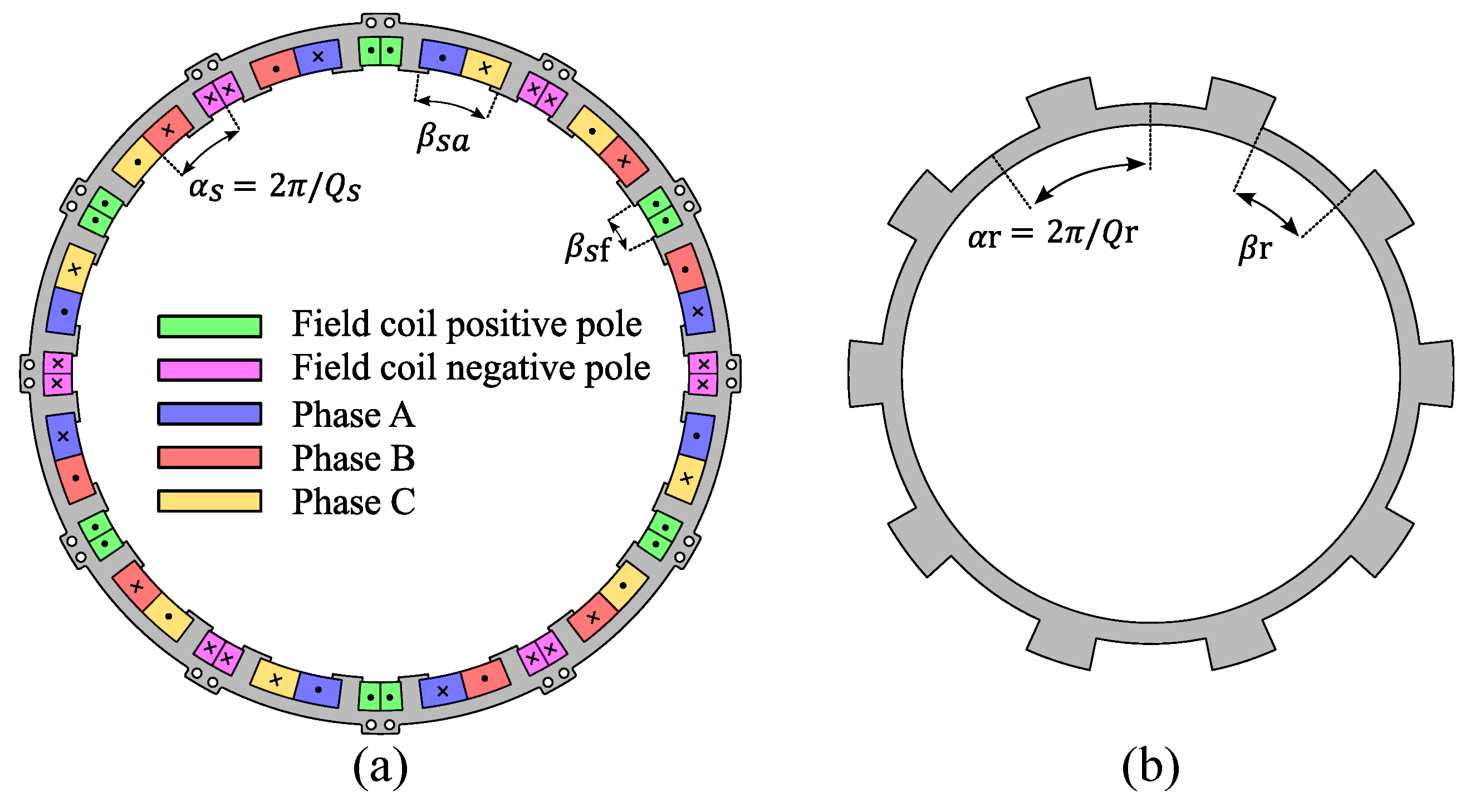

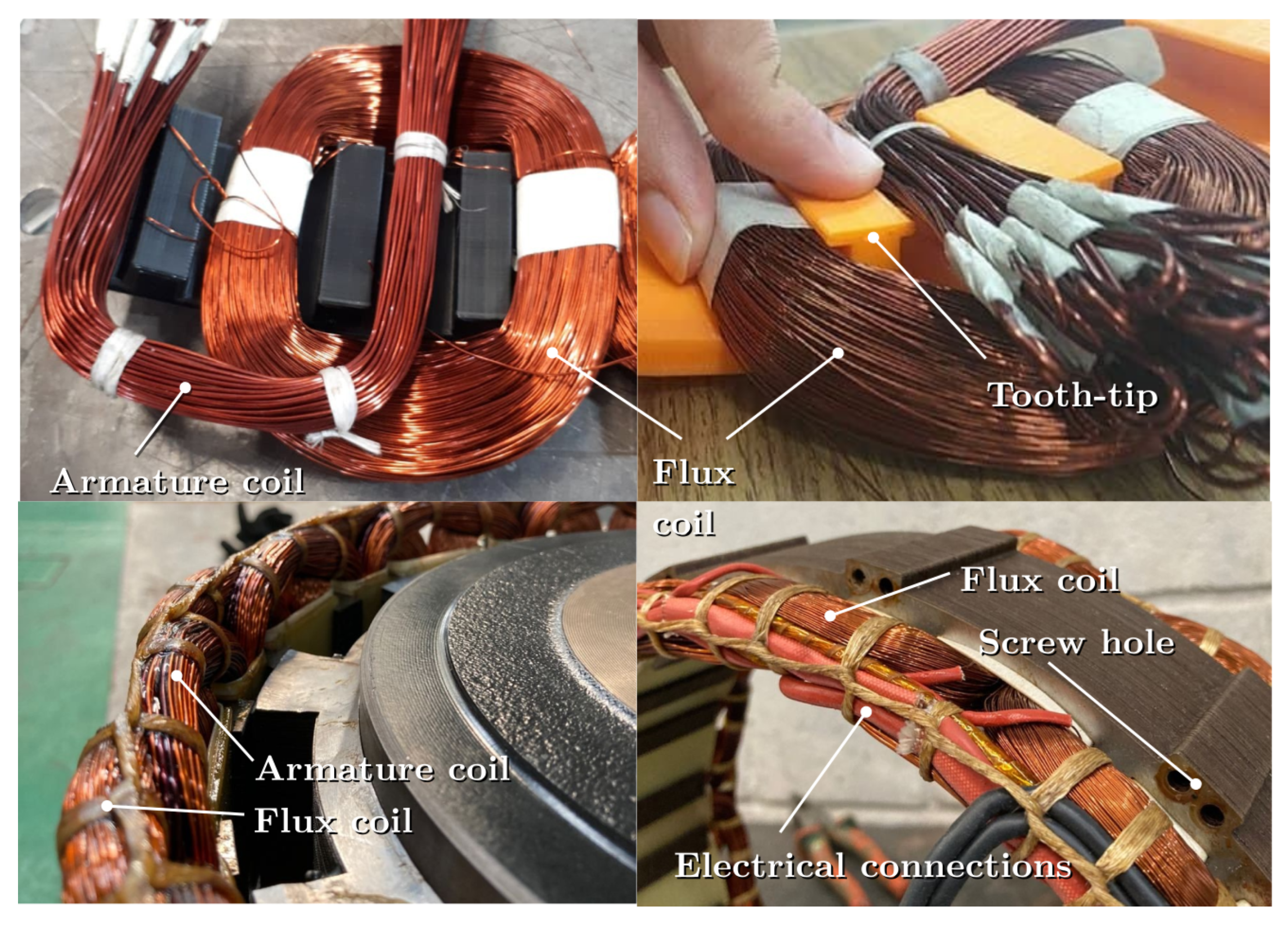
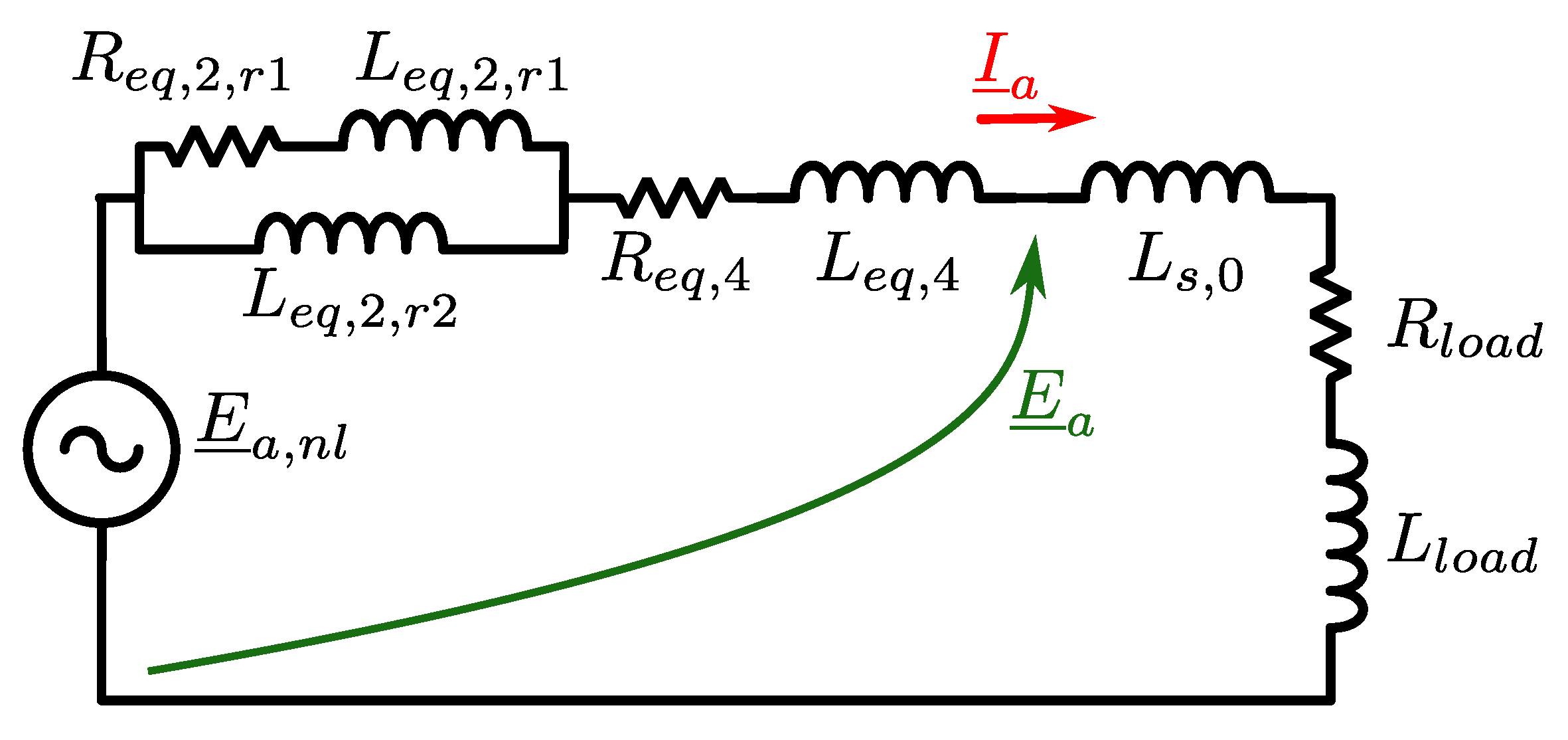
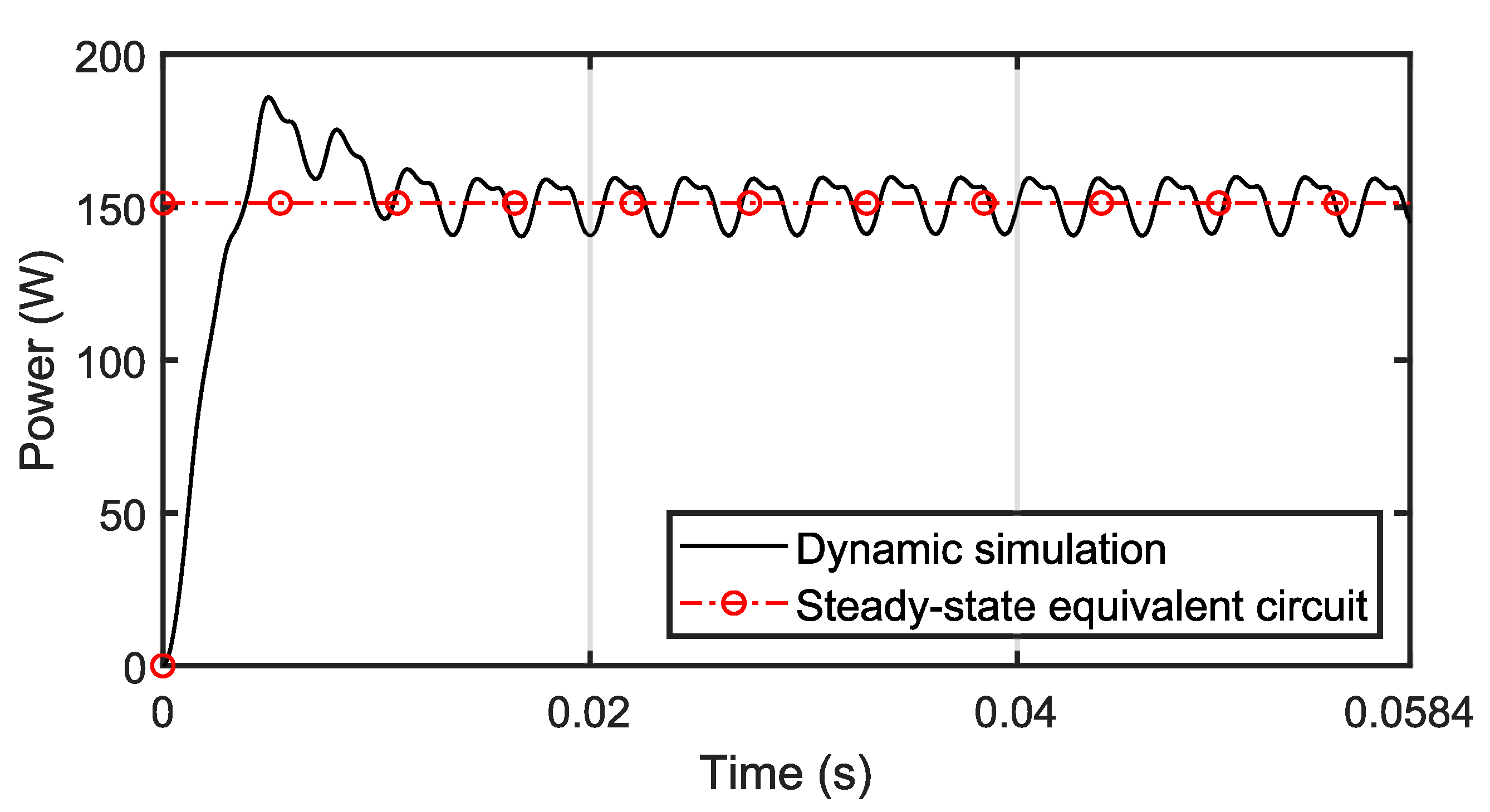
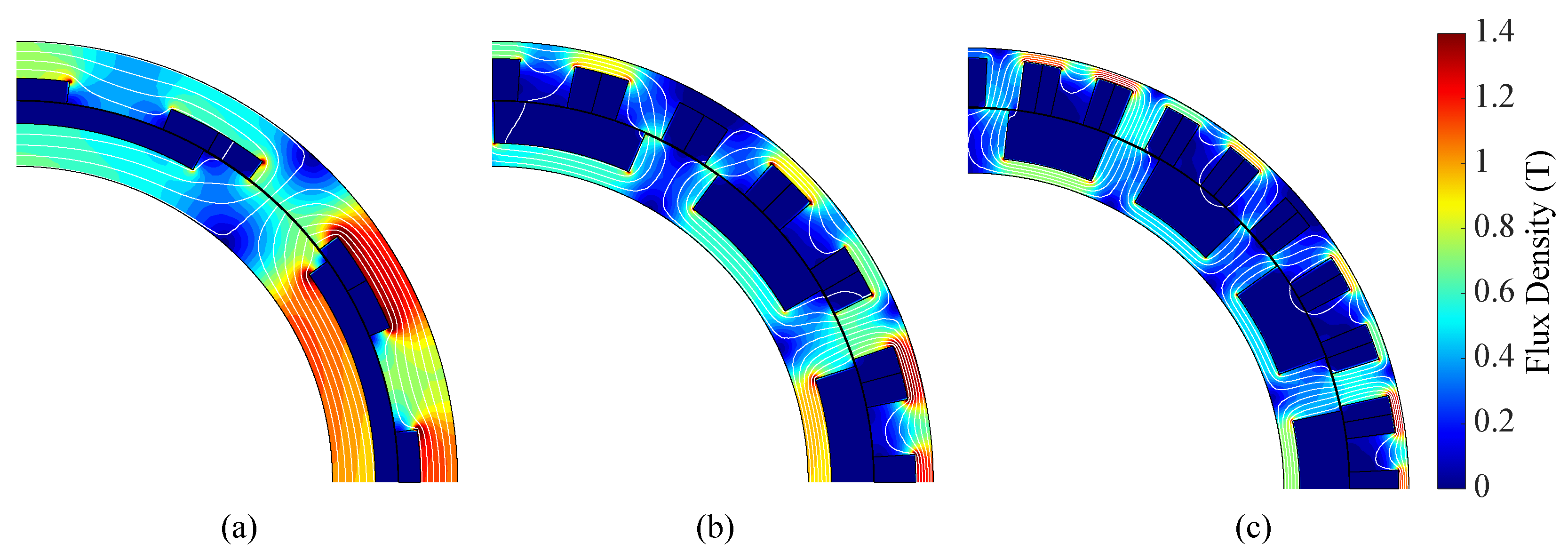
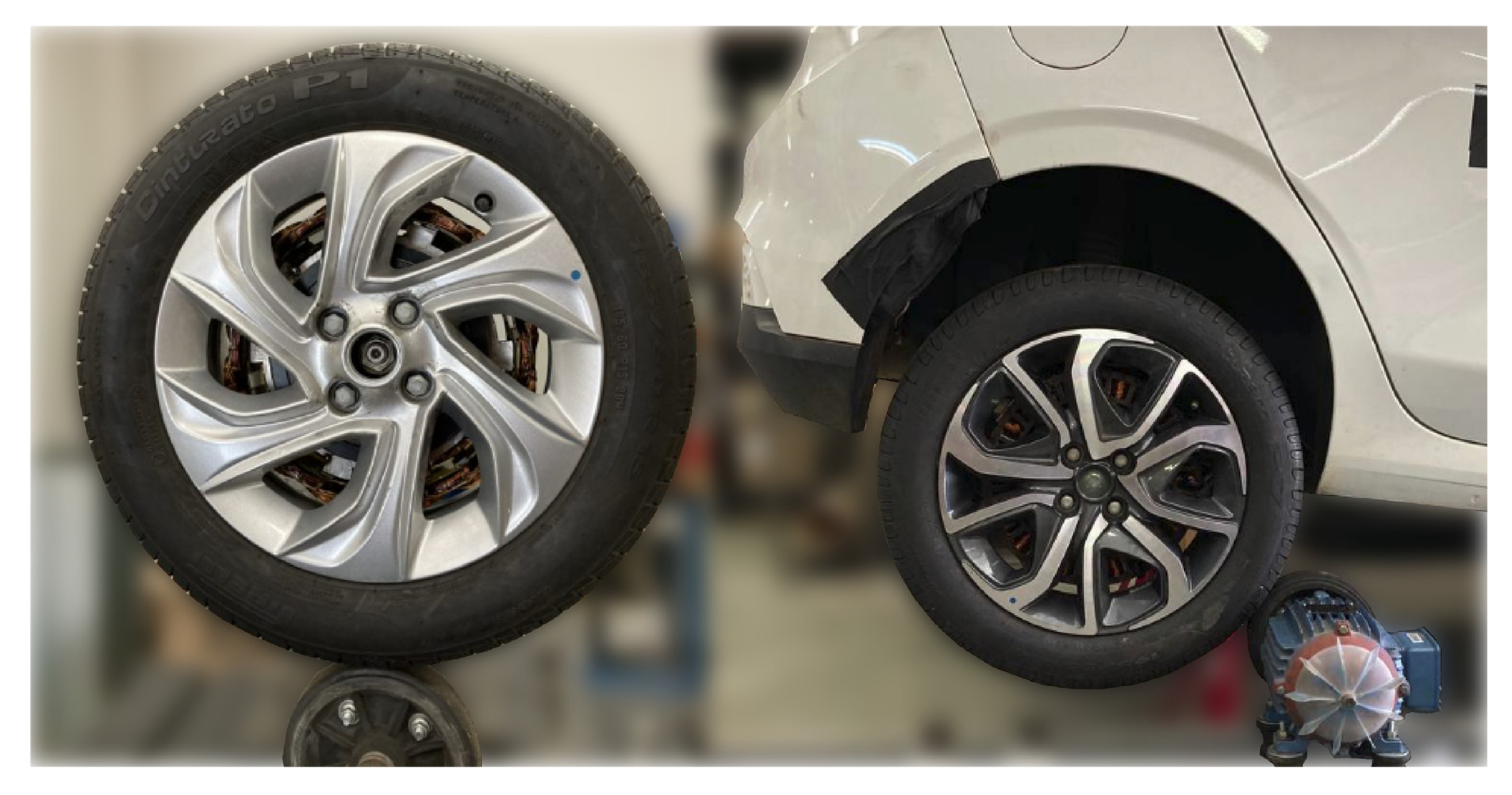
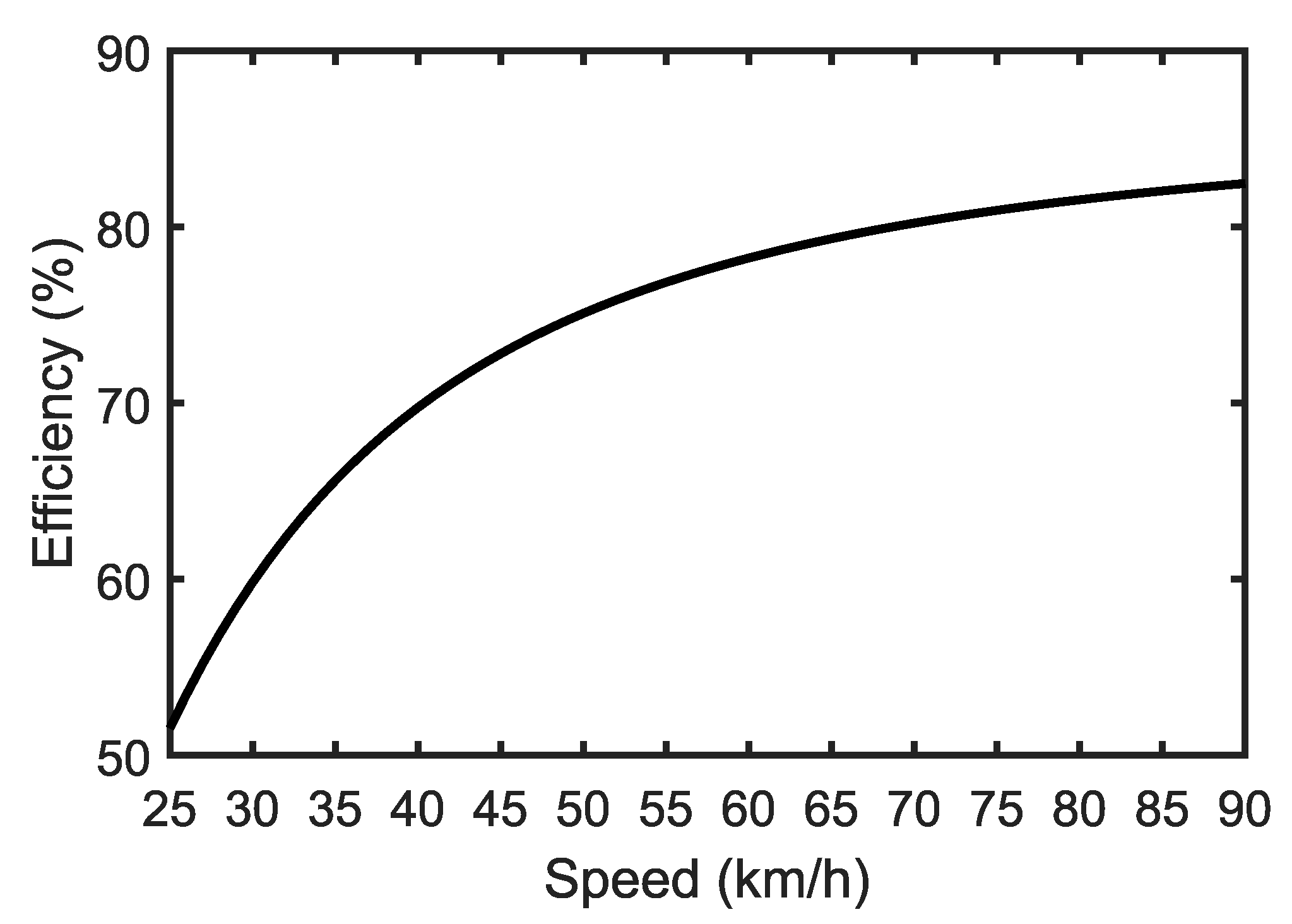
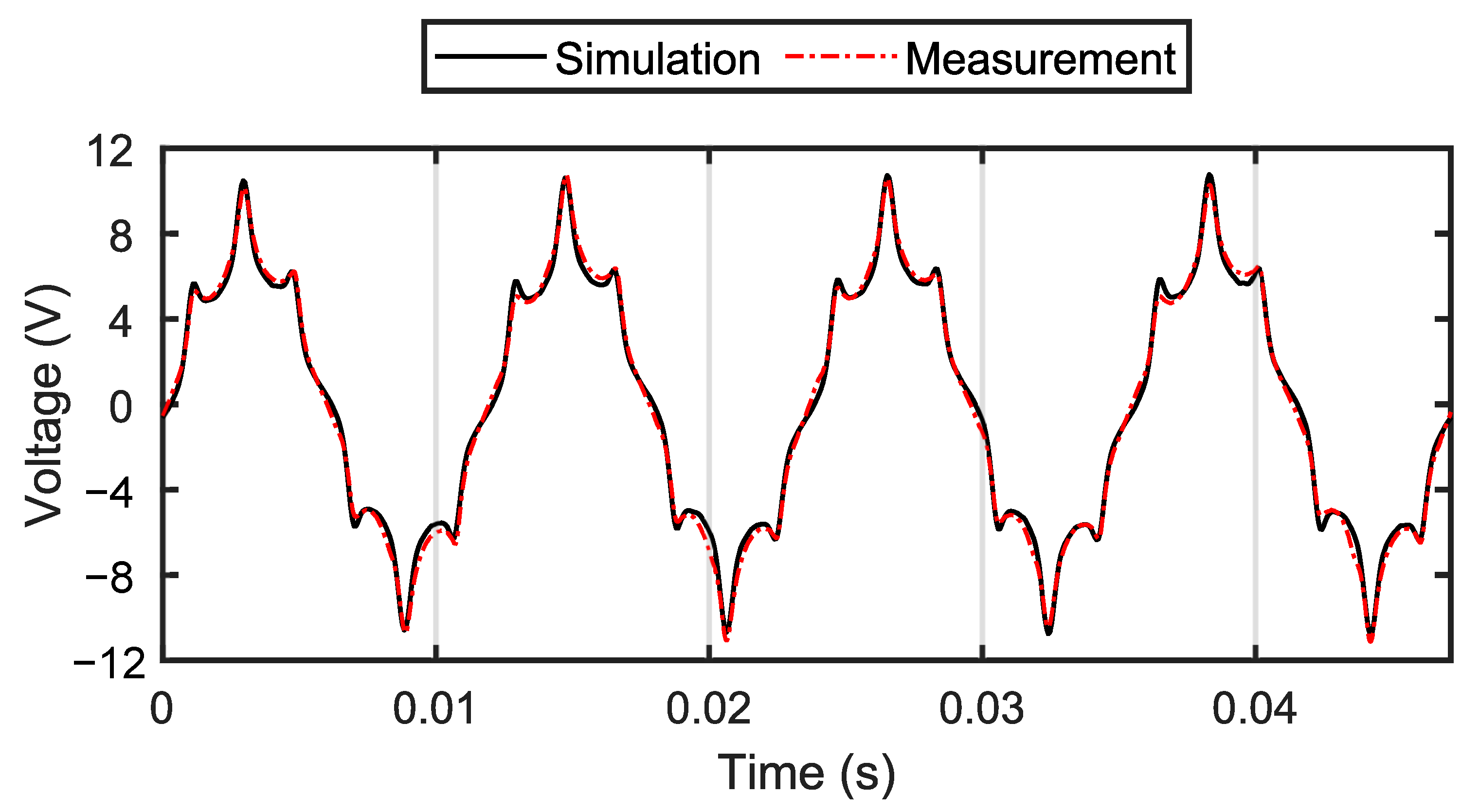
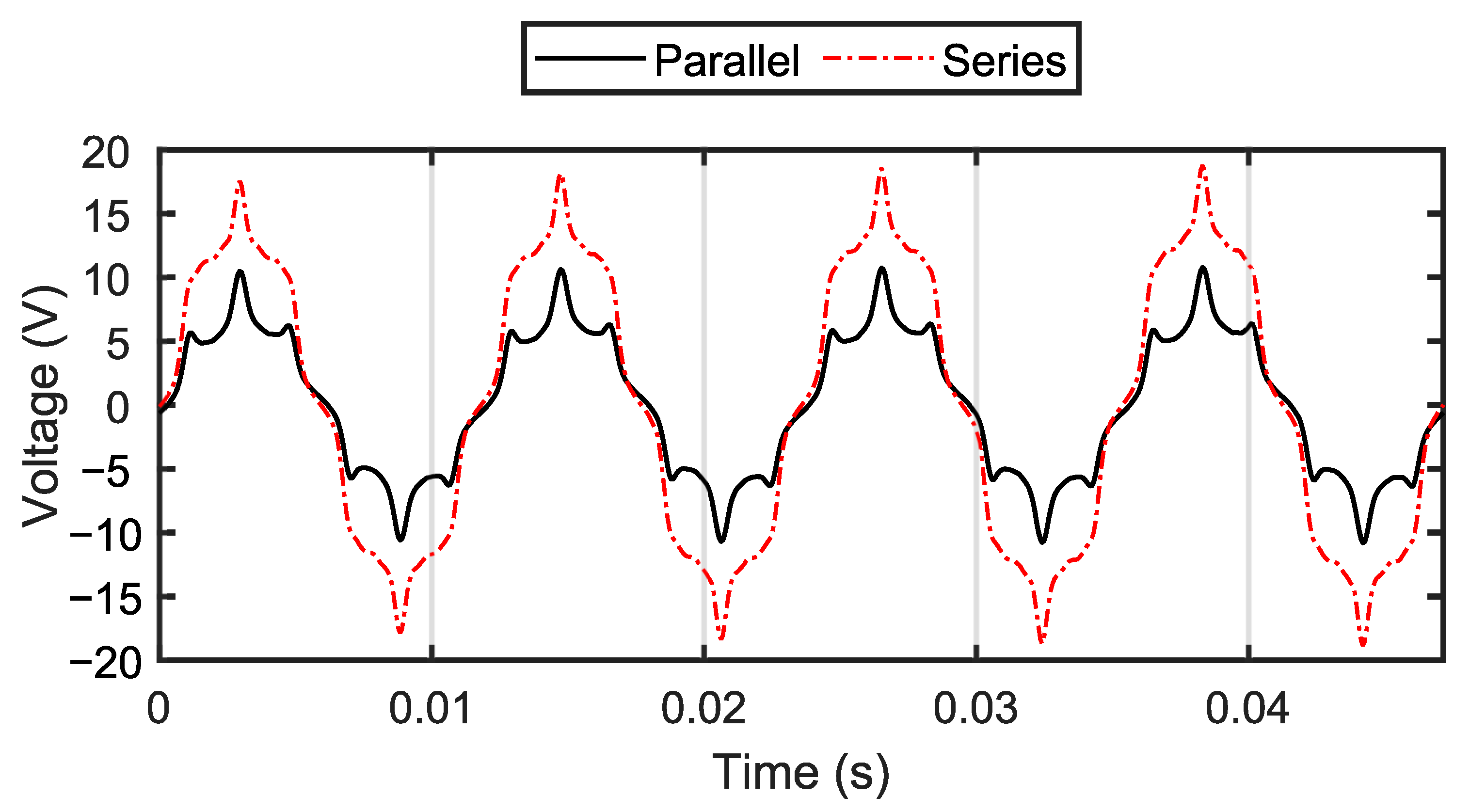
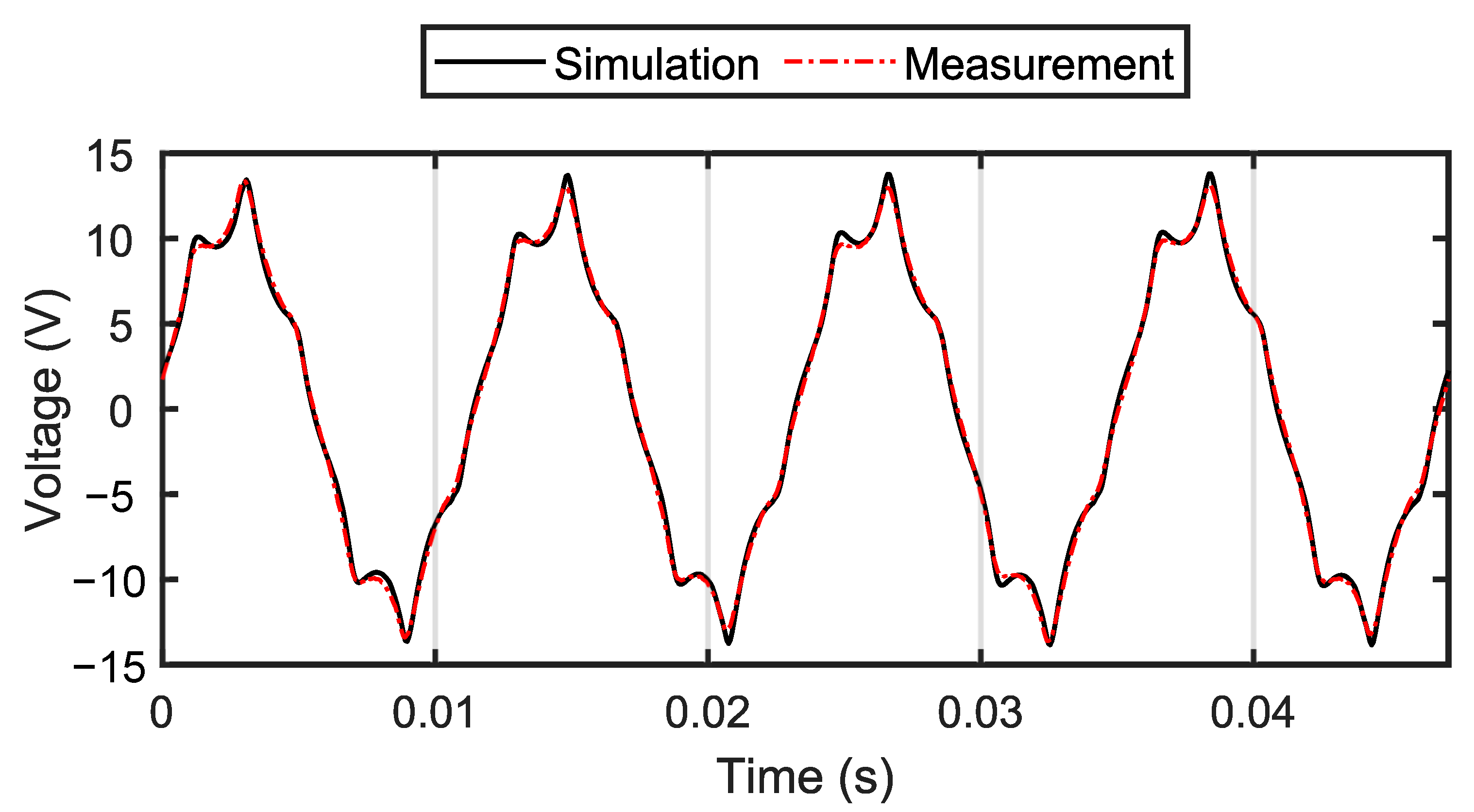
| Parameter | Symbol |
|---|---|
| Air gap radius | |
| Armature slot angular aperture | |
| Armature slot outer radius | |
| Field slot angular aperture | |
| Field slot outer radius | |
| Rotor teeth angular aperture | |
| Rotor slot inner radius | |
| Field winding number of coils | |
| Armature winding number of coils |
| Parameter | Symbol | Value | Unit |
|---|---|---|---|
| Outer radius | 155 | mm | |
| Inner radius | 111 | mm | |
| Axial length | 51 | mm | |
| Air gap length | mm | ||
| Armature coil number of turns | 15 | - | |
| Field coil number of turns | 840 | - | |
| Armature wire gauge | 2 × 18 + 3 × 21 | AWG | |
| Field wire gauge | 27 | AWG |
| Machine Topology | Output Power | Copper Losses |
|---|---|---|
| 12s-5p | 81 W | 62 W |
| 24s-10p | 165 W | 76 W |
| 36s-15p | 148 W | 70 W |
| Flux Density (T) | |||||
|---|---|---|---|---|---|
|
Region Tested |
Rotor Yoke |
Rotor Teeth |
Stator Yoke |
Stator Yeeth |
Linear Model Value |
| Rotor yoke | 1.6 | 0.77 | 0.57 | 1.02 | 1.97 |
| Stator yoke | 0.45 | 0.65 | 1.62 | 0.88 | 1.95 |
| Stator teeth | 0.88 | 1.16 | 0.94 | 1.61 | 1.73 |
Publisher’s Note: MDPI stays neutral with regard to jurisdictional claims in published maps and institutional affiliations. |
© 2022 by the authors. Licensee MDPI, Basel, Switzerland. This article is an open access article distributed under the terms and conditions of the Creative Commons Attribution (CC BY) license (https://creativecommons.org/licenses/by/4.0/).
Share and Cite
Mendonça, G.A.; Galo, D.P.V.; Sales, L.C.M.; Cardoso Filho, B.J.; Maia, T.A.C. Design and Experimental Evaluation of an In-Wheel Flux-Switching Machine for Light Vehicle Application. Machines 2022, 10, 671. https://doi.org/10.3390/machines10080671
Mendonça GA, Galo DPV, Sales LCM, Cardoso Filho BJ, Maia TAC. Design and Experimental Evaluation of an In-Wheel Flux-Switching Machine for Light Vehicle Application. Machines. 2022; 10(8):671. https://doi.org/10.3390/machines10080671
Chicago/Turabian StyleMendonça, Gabriel A., Diogo P. V. Galo, Luís Carlos M. Sales, Braz J. Cardoso Filho, and Thales A. C. Maia. 2022. "Design and Experimental Evaluation of an In-Wheel Flux-Switching Machine for Light Vehicle Application" Machines 10, no. 8: 671. https://doi.org/10.3390/machines10080671
APA StyleMendonça, G. A., Galo, D. P. V., Sales, L. C. M., Cardoso Filho, B. J., & Maia, T. A. C. (2022). Design and Experimental Evaluation of an In-Wheel Flux-Switching Machine for Light Vehicle Application. Machines, 10(8), 671. https://doi.org/10.3390/machines10080671






